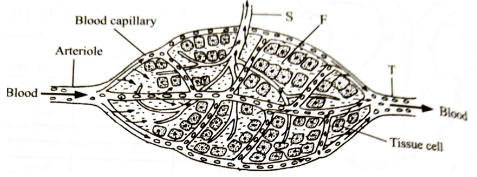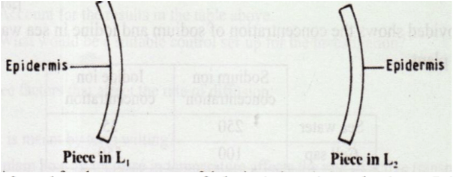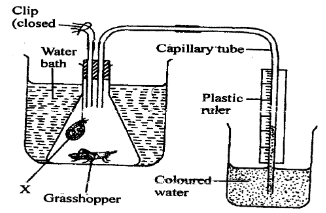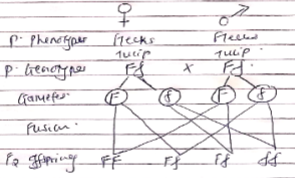INSTRUCTIONS TO CANDIDATES
- This paper consists of two sections: A and B. Answer ALL questions in section A in the spaces provided. In section B, answer question 6 (compulsory) and either question 7 or 8 in the spaces provided after question 8.
- The diagram below shows the site where exchange of substances takes place in the mammalian circulation.

- Name the vessels labelled S and T (2marks)
- Name the fluid labelled F and state its importance (2marks)
- Name the :
- Respiratory substances that move out of the capillaries (1mark)
- Respiratory end products that are removed from tissue cells (1mark)
- Name the blood cells that may be found in the fluid labelled F (1mark)
- Name components of blood that are not found in the fluid labelled F (1mark)
- In tulip plants, the petals can have markings called flecks. There are two alleles for flecks in tulip plants: with flecks F; and without flecks f.
- Explain the meaning of the term dominant allele. (2 marks)
- A tulip grower crosses two tulip plants. He finds that 76 of the offspring have petals with flecks and 23 of the offspring have petals without flecks. Make a genetic cross to explain the results. (4 marks)
- The tulip grower wants to produce a pure-breeding variety of tulips with petals without flecks. State the genotypes of the parent plants he should use to produce tulip plants without flecks. Explain your answer. (2 marks)
- Parental genotypes
- Explanation
- A freshly obtained dandelion stem measuring 5 cm long was split lengthwise to obtain two similar pieces. The pieces were placed in solutions of different concentrations in petri dishes (L.1 and L2) for 20 minutes. The appearance after 20 minutes is as shown

- Account for the appearance of the pieces in solutions Ll and L2 (6 marks)
- State the significance of the biological process involved in the experiment in plants (2 marks)
-
- Describe the process of inhalation in mammals ( 4mrks)
- Explain two ways in which the following structure are adapted to gaseous exchange. (4mrks)
- Mesophyte leaf
- Pneumatophores
- The diagram below illustrates and experiment to determine the rate of respiration in a small insect.
- Name the chemical compound labeled X and state its function. (2 marks)
- Why is it necessary to place the flask in a water bath? (3 marks)
- What changes would you expect to observe in the level of coloured water in the capillary tube after the experiment has run for five minutes? (1 mark)
- Explain the changes you have started in (c) above. (3 marks)
- State how you can set up a control experiment. (1 mark)
SECTION B ( 40 MARKS)
- The data below represents the level of progesterone hormone produced in a female’s body within a period of 34 days. Study the data and use it to answer the questions that follow.
N/B: The days were counted from the 1st day that menstruation was noticed.
Day Progesterone hormone concentration in arbitrary units 1 6 2 5 3 3 4 2 5 1 6 1 8 1 10 2 12 4 14 7 16 8 20 9 22 10 24 10 26 10 28 10 30 11 32 11 34 11 - Plot a graph of progesterone concentration against time using a suitable scale ( 7mrks)
- Account for the progesterone levels in the blood stream between
- Day 1 - day 5 ( 2mrks)
- Day 14 - day 20 ( 2 mrks)
- Day 28 - day 35 (2mrks)
- Name two structures that produce progesterone in females ( 2mrks)
- Suggest the process that usually takes place at day 14 ( 1mrk)
- Suggest two other hormones that were in high concentration in the body of the female between days 11 -- 15. Give reasons for your answer. ( 4mrks)
-
- Explain the mechanism of protein digestion in man (12 mrks)
- Discuss how the following factors affects the distribution of living organism in an ecosystem.
- Competition (4mrks)
- Wind (4mrks)
-
- Giving examples discuss how the following evidences of organic evolution show that evolution show that evolution has taken place.
- comparative anatomy (6mks)
- geographical distribution (4mks)
- comparative cell Biology (3mks)
- Describe how water moves from the soil to the xylem vessels ( 8mrks)
- Giving examples discuss how the following evidences of organic evolution show that evolution show that evolution has taken place.
MARKING SCHEME
- The diagram below shows the site where exchange of substances takes place in the mammalian circulation.
- Name the vessels labelled S and T (2marks)
- S – lymphatic vessel ;
- T – venule ;
- Name the fluid labelled F and state its importance (2marks)
- Tissue fluid ; forms medium through which exchange of materials between blood and tissue cells takes place;
- Name the :
- Respiratory substances that move out of the capillaries (1mark)
- Oxygen gas and glucose;
- Respiratory end products that are removed from tissue cells (1mark)
- Carbon (IV) Oxide gas, excess water, lactic acid;
- Respiratory substances that move out of the capillaries (1mark)
- Name the blood cells that may be found in the fluid labelled F (1mark)
- Lymhocytes;
- Name components of blood that are not found in the fluid labelled F (1mark)
- Erythrocytes and Plasma proteins;
- Name the vessels labelled S and T (2marks)
- In tulip plants, the petals can have markings called flecks. There are two alleles for flecks in tulip plants: with flecks F; and without flecks f.
- Explain the meaning of the term dominant allele. (2 marks)
- The allele that express itself both in homozygous and heterozygous condition;
- A tulip grower crosses two tulip plants. He finds that 76 of the offspring have petals with flecks and 23 of the offspring have petals without flecks. Make a genetic cross to explain the results. (4 marks)
- The tulip grower wants to produce a pure-breeding variety of tulips with petals without flecks. State the genotypes of the parent plants he should use to produce tulip plants without flecks. Explain your answer. (1 marks)
- Parental genotypes
ff x ff - Explanation. ( 1mrks)
both parents must have a recessive allele / (if ff × ff) no dominant or F allele, in either parent / (if ff × ff) both parents must be homozygous, recessive / without flecks no parent must be homozygous dominant / presence of (even) one dominant allele in parents could result in flecks; ( owtte)
- Parental genotypes
- Explain the meaning of the term dominant allele. (2 marks)
- A freshly obtained dandelion stem measuring 5 cm long was split lengthwise to obtain two similar pieces. The pieces were placed in solutions of different concentrations in petri dishes (L.1 and L2) for 20 minutes. The appearance after 20 minutes is as shown
- Account for the appearance of the pieces in solutions Ll and L2 (6 marks)
- Li - Inner cells gained water by Osmosis; hence increased in length; epidermal cells did not gain water/gained less water/ gained water at a slower rate because they are covered by a water proof cuticle leading to curvature;
- L2 - Inner cells lost water by osmosis; leading to (flaccidity) decrease in length; epidermal cells did not lose water/ lost less water/ at a slower rate due to waterproof leading to curvature;
- State the significance of the biological process involved in the experiment in plants (2 marks)
- Absorption of water by the roots;
- Opening and closing of the stomata;
- Support in herbaceous plants;
- Feeding in insectivorous plants;
- Account for the appearance of the pieces in solutions Ll and L2 (6 marks)
-
- Describe the process on inhalation in mammals ( 4mrks)
- During inhalation, the external intercostal muscles contract, while the internal intercostal muscles relax;
- This movement pulls the ribs upwards and outwards;
- The diaphragm which is normally dome shaped flattens by contraction of its muscles;
- The flattening of the diaphragm together with the outward movement of the ribs increases the volume of the thoracic cavity and decreases the pressure inside it;
- Lung increase in volume and pressure decreases;
- Atmospheric pressure being higher than pressure inside the thoracic cavity forces air to rush into the lungs through the nose and trachea hence inflating the lungs;
- Explain two ways in which the following structure are adapted to gaseous exchange. (4mrks)
- Mesophyte leaf
- Broad/ flat leaf lamina to provide a large surface area for absorption of gases;
- It is thin to allow gases to diffuse through a short distance;
- Presence of air spaces for easy circulation of gases;
- Presence of stomata to allow gases to diffuse in and out of the leaf;
- Pneumatophores
- Contains numerous lenticels for efficient exchange of gases;
- Emerge above the soil or water to absorb gases and expel gases;
- Mesophyte leaf
- Describe the process on inhalation in mammals ( 4mrks)
- The diagram below illustrates and experiment to determine the rate of respiration in a small insect.
- Name the chemical compound labeled X and state its function. (2 marks)
- Sodium hydroxide ; To absorbs the carbon (IV) oxides produced:
- Why is it necessary to place the flask in a water bath? (3 marks)
- To maintain an almost constant temperature during the period of the experiment ; a small rise in temperature causes air to expand ; a small fall in temperature causes air to contract ; leading to erroneous results;
- What changes would you expect to observe in the level of coloured water in the capillary tube after the experiment has run for five minutes? (1 mark)
- The level of water in the capillary would rise;
- Explain the changes you have started in (c) above. (3 marks)
- The insect respired taking up oxygen ; releasing carbon (IV) oxide which is absorbed by Sodium Hydroxide; up take of oxygen caused a decrease in air pressure within the flask / created a partial vacuum;
- State how you can set up a control experiment. (1 mark)
- Using a dead insect; Ommit sodium hydroxide;
- Name the chemical compound labeled X and state its function. (2 marks)
SECTION B (40 MARKS)
- The data below represents the level of progesterone hormone produced in a female’s body within a period of 34 days. Study the data and use it to answer the questions that follow.
- Plot a graph of progesterone concentration against time using a suitable scale ( 7mrks)
- Account for the progesterone levels in the blood stream between
- Day 1 - day 5 ( 2mrks)
- Level of progesterone was going down; corpus luteum has disintergrated;
- Day 14 - day 20 ( 2 mrks)
- Level of progesterone increasing rapidly, to stimulate thickening and increased blood supply in the endometrium in preparation of implantation of the blastocyst;
- Day 28 - day 35 (2mrks)
- Level of progesterone increases further; this is because implantation has taken place and progesterone is required to maintain pregnancy;
- Day 1 - day 5 ( 2mrks)
- Name two structures that produce progesterone in females ( 2mrks)
- Ovaries;/ corpus luteum;
- Placenta;
- Suggest the process that usually takes place at day 14 ( 1mrk)
- Ovulation;
- Suggest two other hormones that were in high concentration in the body of the female between day 11 -- 15. Give reasons for your answer. ( 4mrks)
- Oestrogen;
- Stimulate repair and healing of the endometrium;
- Stimulate the anterior lobe of the pituitary gland to secrete luteinizing hormone;
- Luteinizing hormone; stimulates ovulation;
- Oestrogen;
-
- Protein is chewed by teeth; to increase surface area for digestion; presence of food in mouth stimulates secretion of saliva by salivary glands; tongue mixes food with saliva; water in saliva dissolves soluble food materials; mucus lubricates lining of mouth and food materials; tongue rolls food into boluses; and pushes them back to the mouth for swallowing; food moves down the oesophagus by peristalsis; into the stomach through cardiac sphincter; gastric glands secrete gastric juice; hydrochloric acid in gastric juice kills some micro-organism swallowed with food; activates pepsinogen to pepsin; provides suitable acidic condition for activity of pepsin; pepsin digests proteins to peptides; stomach walls churn food into acidic chyme; which leaves via pyloric sphincter; into duodenum; pancreatic juice and bile are secreted into the duodenum;trypsinogen is activated to trypsin; bile salts neutralize acidic chyme to allow digestion of remaining protein by trypsin into peptides; food arrives into the ileum; succus entericus/intestinal juice is secreted; peptidase in the intestinal juice digests peptides to amino acids.
(15 marks)
(MAX.12 MARKS) - Competition (4 marks)
When two organisms feed on a common resource whose supply is limited, they are said to be in competition; (such resources include space, light, mates and nutrients) there are two types of competition namely, intraspecific ( between individuals of same species) and interspecific ( between individuals of different species); Competition among organism may continue especially when resources are limited until they are all depleted; organism with better adaptation survive while those that are less adapted may either migrate or die;
Acc any relevant example given - Wind (4 marks)
Wind is air in motion that affects distribution of living organism in following ways;- Blow away rain bearing clouds
- Seed dispersal
- Pollination
- Transpiration
- Waves and tides in sea destroying aquatic life
- Brings cooling effect in plants
- Enhance mating by bringing pheromones from female to male
- Agent of soil erosion
- Lodging of trees and fodder crops.
Acc any four well explained points.
- Protein is chewed by teeth; to increase surface area for digestion; presence of food in mouth stimulates secretion of saliva by salivary glands; tongue mixes food with saliva; water in saliva dissolves soluble food materials; mucus lubricates lining of mouth and food materials; tongue rolls food into boluses; and pushes them back to the mouth for swallowing; food moves down the oesophagus by peristalsis; into the stomach through cardiac sphincter; gastric glands secrete gastric juice; hydrochloric acid in gastric juice kills some micro-organism swallowed with food; activates pepsinogen to pepsin; provides suitable acidic condition for activity of pepsin; pepsin digests proteins to peptides; stomach walls churn food into acidic chyme; which leaves via pyloric sphincter; into duodenum; pancreatic juice and bile are secreted into the duodenum;trypsinogen is activated to trypsin; bile salts neutralize acidic chyme to allow digestion of remaining protein by trypsin into peptides; food arrives into the ileum; succus entericus/intestinal juice is secreted; peptidase in the intestinal juice digests peptides to amino acids.
-
-
- COMPARATIVE ANATOMY
Anatomy is the study of structures of living organisms. Comparative anatomy is comparison of internal structures of various organisms. Some show basic structural similarities and this suggests that the organisms have a common or related ancestry i.e. homologous structures, but are modified to perform different functions. They have gone through divergent evolution.
Examples of homologous structures are beaks of birds, feet of birds, pentadtyl limb in mammals. Other structures show basic structural differences since they have different embryonic origin but have gone through convergent evolution and modified to perform similar function. This are analogous structures e.g. wings of bats, insects and birds. Others are vestigial structures- those structures in course of time become greatly reduced and become function less. This indicate that they were present in their ancestral forms which have since evolved e.g. Coccyx- tails in human, body hair, reduce wings in flightless birds like kiwi. - GEOGRAPHICAL DISTRIBUTION
The theory of continental drift supposes that at some time the present day continents were one single landmass which later broke up into parts which drifted apart. Closely related organisms were separated and isolated from one another thus evolving differently, with time leading to formation of different species through natural selection. Each group of organisms adapted to different set of environmental conditions e.g. camels in Africa and llama in South America. - COMPARATIVE SEROLOGY/CELL BIOLOGY
Comparative cell biology is a comparison of different blood proteins in different organisms. This study shows that organisms that are closely related or have a common ancestry have similar blood proteins which is tested using antigen-antibody reaction. Where precipitate from varies from one animal to another. Greater amount of precipitate shows many common antigen hence common antibodies hence more reaction. This indicates that the organisms have a common ancestry. Less amount of precipitate show that few or none antigen is common in organisms hence are apart i.e. common ancestry.
Increase genetic variations to all organisms to adapt to environmental/heterozygosity
Bring about beneficial/advantageous traits e.g. leads to malaria resistance in human with sickle cell trait and leads to antibiotic resistant strains of bacteria to allow them to survive in presence of drugs
- COMPARATIVE ANATOMY
- Water exists as a thin film in the soil/between soil particles; The concentration of cell sap of root hair is greater than that of the surrounding solution in the soil; thus drawing the water molecules across the cell membrane into the root hair cell; by osmosis; water drawn into the root hair dilutes the cell sap/makes it less concentrated than that in the adjacent cortex; from cell to cell by osmosis; across the endodermis by active transport; into xylem vessels; then conduct the water up into the xylem of the stem;
-
Join our whatsapp group for latest updates
Tap Here to Download for 50/-
Get on WhatsApp for 50/-
Download Biology Paper 2 Questions and Answers - Mokasa 1 Joint Mocks Exams 2023.
Tap Here to Download for 50/-
Get on WhatsApp for 50/-
Why download?
- ✔ To read offline at any time.
- ✔ To Print at your convenience
- ✔ Share Easily with Friends / Students


